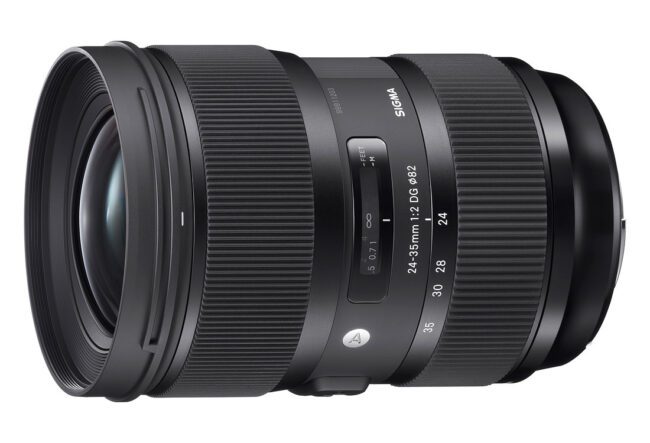Suggested 35mm Sigma Art Settings for Dock With Nikon D750
Ever since Sigma announced their new direction with reorganizing new lenses into three different "Contemporary", "Art" and "Sports" production lines, the company has been successfully rolling out a number of truly groundbreaking lenses. We were diddled away by the optical quality of the Sigma 35mm f/1.4 Fine art lens, which topped our lens charts as one of the sharpest lenses we take seen to date. Then we welcomed the updated Sigma 50mm f/ane.4 Art and were quite inspired by globe's beginning f/1.8 constant aperture zoom lens, the xviii-35mm f/i.viii Art.
Earlier this year, Sigma announced yet another addition to the "Art" line of lenses, again in the "world's first" category, the Sigma 24-35mm f/2 DG HSM Fine art. Built on the concept of the 18-35mm f/1.8 Art, the 24-35mm f/ii was redesigned to cover the full-frame image circle, while maintaining the superb optical performance. The result was a larger and heavier lens, but one that was to challenge primes from 24mm to 35mm focal lengths. Set on to go head to caput with such primes specifically, the biggest question I had was – could this lens actually optically challenge prime lenses? If it performed well optically, that'due south a single lens that could potentially replace such lenses as the Nikkor 24mm f/ane.8G, 28mm f/1.8G and 35mm f/1.8G in a single package – a rather tough challenge, as those lenses are quite stiff performers on their own.

With a fast aperture of f/2, the 24-35mm Art is an attractive pick for many types of photography. Having photographed a wedding with the lens, I found bang-up use for such a lens when capturing groups and doing environmental portraits. It is not a slow zoom like the sixteen-35mm f/4 and those two stops of low-cal do thing quite a bit when shooting in low-light churches or dimly lit rooms. That's ISO 1600 vs ISO 6400, or 1/25 vs i/100.
The focal length coverage of the lens is also corking for photographing landscapes and architecture. I personally beloved shooting at 24mm and 35mm focal lengths, so having those two in a unmarried package sounded quite good. I am express to f/2.8 with my Nikkor 24-70mm f/ii.8G, which is why I oftentimes resort to primes when shooting a dark night sky, as even a stop of light tin brand a huge difference. And shooting at f/1.4 or f/i.8 is not something I will typically do, since fast aperture primes usually don't practice very well at the widest aperture, and then I observe myself shooting in the f/2 range with those anyway.

To sum up, despite the fact that the 24-35mm range sounds a chip too narrow, particularly when you take many other lens options covering more, it all comes downwardly to pure optical performance. If the 24-35mm f/ii is as solid as other primes stopped downwardly to f/2, i would non need to compare it to other zooms, which is where Sigma is aiming. And as I reveal in the subsequent sections of this review, that'due south exactly what Sigma has achieved with this optical curiosity. Without giving more spoilers, let's take a wait at the Sigma 24-35mm f/2 Art in detail and see what it has to offer.
Sigma 24-35mm f/two DG HSM Art Specifications
- Mount Type: Sigma, Nikon, Catechism, Sony and Pentax
- Focal Length: 24-35mm
- Maximum Aperture: f/two
- Minimum Aperture: f/xvi
- Lens Construction: 18 Elements in thirteen Groups
- Angle of View: 84.1º-63.4º
- Number of Diaphragm Blades: 9 (rounded)
- Minimum Focusing Distance: 28cm/11in
- Filter Size: 82mm
- Maximum Magnification: 1:4.four
- Dimensions (Diameter 10 Length): 87.vi×122.7mm / 3.iv×iv.8in
- Weight: 940g/33.2oz.
- A lens hood, front & rear lens caps and conveying example are included with the lens
Other technical information, including manufacturer-provided MTF nautical chart can exist found in the Sigma 24-35mm f/ii DG HSM page from our lens database.

Lens Handling and Build
The Sigma 24-35mm f/ii DG HSM is built very well, just similar all other Fine art-series lenses – it has a very nice all-metallic barrel and a metal mount. The lens feels very solid in hands and it has a better feel to information technology than Nikon'due south plastic primes, which feel rather inexpensive in comparing. To be able to make such a broad aperture possible throughout the focal length range, Sigma had to make the front chemical element of the lens rather large, which certainly impacted the overall size and weight of the lens. As a result, the lens features a big 82mm filter thread, which can exist rather painful for some photographers, since 82mm filters are usually quite expensive when compared to smaller 77mm filters. I personally had to spring for the B+West 82mm HTC Kaezemann Nano Polarizer and it was non cheap at over $200 (and I would not recommend anything less if yous want the best paradigm quality) simply to be able to use it with this lens.
At 940 grams / 33.two ounces, the Sigma 24-35mm f/2 is a chip heavy when compared to lightweight primes. Still, it would be a mistake to compare such a lens with a single prime. The Nikkor 24mm f/1.8G, 28mm f/1.8G and 35mm f/1.8G collectively counterbalance 990 grams, which is basically what this single lens would be replacing. While 50 grams might not audio like a lot, the infinite savings, the time savings and the versatility of the 24-35mm (especially in dusty environments) are huge.

Focusing with the Sigma 24-35mm f/2 is a breeze – the focus ring is located on the front of the lens butt and it is very shine and easy to rotate, making the lens a great candidate for manual focusing. Be warned though, if y'all have been shooting with Nikon lenses, continue in listen that all Sigma lenses rotate in the opposite direction like Canon lenses do. Not an event for most people, only can take some fourth dimension to become used to, especially with Nikon viewfinders showing rotation in the reverse direction when looking at the focus aid indicators.
There is a switch on the side of the lens to motion betwixt Autofocus and Manual Focus, similar to the switches found on Nikkor lenses. The Sigma 24-35mm f/2 Art comes with a plastic petal blazon hood that stays securely locked in one case mounted on the front of the lens.
There is little to complain almost in terms of the lens build except one area – weather condition sealing. While the lens itself probably can take enough of abuse, the lens mount is not sealed with a rubber gasket like the new Nikon lenses. This means that you accept to watch out for grit between the lens and the camera mountain or it will easily get in into the camera and potentially even into the lens. As I explained in my "what to exercise with grit inside lenses" article, it is quite normal for lenses to suck air in and out when focusing or zooming in/out, so I recommend to try to keep the rear metal mount expanse make clean at all times.

Autofocus Performance and Accuracy
The Sigma 24-35mm f/2 Art features the aforementioned high quality "HSM" hyper-sonic motor found on other Sigma lenses, which provides fast and quiet autofocus operation. Autofocus accuracy is too excellent and I used the lens on a variety of Nikon DSLR camera bodies, including the loftier-resolution Nikon D810 – none of them had whatever front or back focus bug. And if I had any focus accuracy issues, I could have hands taken intendance of those with the Sigma USB Dock, which is a must-have tool, especially if yous already own or planning to ain more than one Sigma lens. That's one of the biggest advantages of the new generation Sigma lenses, as y'all tin can non merely update lens firmware, but likewise calibrate lenses individually without messing with AF Micro-Adjustment settings. I ran a number of different AF accuracy tests with the LensAlign lens calibration tool and the lens was spot on at all times and there was no need for boosted calibration. This speaks for the new QA controls and high standards, which Sigma surely deserves to be praised for.

Source: https://photographylife.com/reviews/sigma-24-35mm-f2-dg-hsm-art
0 Response to "Suggested 35mm Sigma Art Settings for Dock With Nikon D750"
Post a Comment